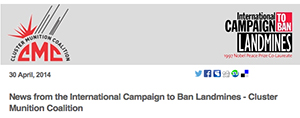Disarm
ICBL calls on states to destroy their stockpiles of antipersonnel landmines, and report on progress of stockpile destruction, in addition to reporting on planned and actual use of retained mines.
STOCKPILE DESTRUCTION
States that are part of the Mine Ban Treaty must destroy their stockpiles of antipersonnel mines no later than four years after joining the treaty.
Stockpile destruction is the most effective form of preventive mine action: destroyed mines will never claim any victims. It has also been the most successful provision of the treaty: 86 States Parties have declared that they do not retain any antipersonnel mines, including 34 states that stockpiled antipersonnel mines in the past, destroying over 53 million antipersonnel mines. A handful of States Parties are still in the process of destroying their stocks.
Some states still report new stockpiles even after completing destruction (mines can be discovered, captured, seized, or turned-in). They need to destroy those stocks as quickly as possible.
ICBL CALLS
on States Parties to the Mine Ban Treaty with stockpiles to:
- Destroy stockpiles without further delay
- Fix a target end date for destruction and report regularly on progress made
- Hold public destruction events to promote transparency and regional confidence-building
- Report on and seek help in addressing any problems in destroying stockpiles.
STATES PARTIES WITH STOCKPILES
States that missed their deadline:
- Ukraine has 4.9 million antipersonnel mines remaining to be destroyed
- Greece has 643,267 mines remaining to be destroyed.
MINES RETAINED FOR TRAINING
Mine Ban Treaty members are allowed to retain or transfer mines for training and research in mine clearance, but this number should “not exceed the minimum number absolutely necessary” for those purposes. Governments have also committed to regularly reviewing the number of mines retained and destroying any over the minimum number strictly necessary.
A total of 71 States Parties have reported they are retaining mines. Many states are still retaining mines, but apparently not using them for permitted purposes. The number of mines they retain remains the same year after year, indicating none are consumed during training or research. Some states retain mines even though they are not known to engage in any research or training activities.
ICBL CALLS
on states that retain antipersonnel mines for training under the Mine Ban Treaty to:
- Report on the planned and actual use of retained mines
- Regularly evaluate the number of retained mines to ensure it is the minimum number absolutely needed for live mines in training and research activities, and destroy any mines above this number
- Explore available alternatives to using live mines for training and research activities.
WHICH STATES
States Parties retaining high numbers of mines: Finland, Turkey, Bangladesh, Sweden, Greece, and Croatia.
States that have not reported consuming any mines for permitted purposes since joining the treaty: Burundi, Cape Verde, Cyprus, Djibouti, Nigeria, Oman, Senegal, and Togo.
DEFINITION OF ANTIPERSONNEL MINES
The Mine Ban Treaty defines "antipersonnel mine" as a “mine designed to be exploded by the presence, proximity or contact of a person and that will incapacitate, injure or kill one or more persons.” The ICBL and many states have affirmed that this definition applies to any type of mine that can be set off by the unintentional act of a person. Therefore, antivehicle mines equipped with tripwires, breakwires, tilt rods, or highly sensitive anti-handling devices should be considered banned by the treaty. Mines that can be set off on command or by a tripwire (e.g. Claymore and OZM-72 mines) can only be considered legal when used in command-detonated mode.
ICBL CALLS
on states and non-state armed groups to:
- Destroy all mines that function as antipersonnel mines regardless of what they are called
- Destroy all fuzes that can be attached to antivehicle mines to make them victim-activated
- Make sure that mines with both command- and person-activated fuzes are permanently modified to function in command-detonated mode only.


